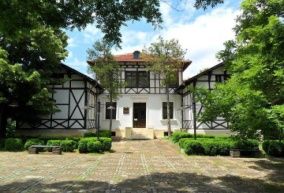

The Renaissance – Ethnographic complex, “Saint Sofronius Vratsa” covers a surface of 5, 5 acres, on which there are three Renaissance houses with a typical architectural style for this region and two public buildings from the same period – the house of the family Hadzhitoshev and the house of Ivan Zambin by Grigor Naidenov, the Renaissance school building the “Ascensions” and the “Holy Ascension”. All these have been declared historical and architecture monuments.
The construction of the complex is executed in stages. In the year 1976 it is opened to the visitors the museum – house “Dimitraki Hadzhitoshev”.
After finishing the construction and re-conditioning works, at the middle of the years ’80 there were prepared for the opening the exhibits from the Renaissance School the “Ascensions”, the house of Ivan Zambin by Grigor Naidenov, the “Holy Ascension of God” and the accommodation spaces especially built for exhibiting the traditional vehicles and the agricultural equipments. The official opening of the complex is made on the 25th of May 1986.
The exhibits EER “Saint Sofronius Vratsa”, show the most characteristics of the traditional popular culture of the population from Vratsa, the regional differences and the unity of the popular culture from all Bulgaria. Built on the historical sequence, the posting of the processes and of the ethnographical events, in a chronological order, cover the period from the middle of the XIXth century and the first decades of the XXth century. At the first floor there can be seen two exhibit auditoriums which present the day-to-day life and the holiday clothing of the inhabitants from Vratsa in the second half of the 19th century and from the community the “Banat”. At this point you will see types of traditional food, bread, arbors and other. The theme of the second floor is a formation of brass from Vratsa, founded by Diko Iliev.
